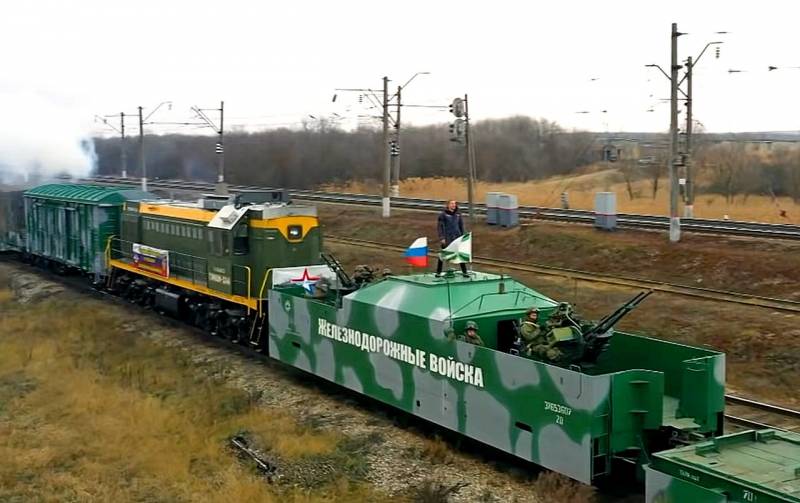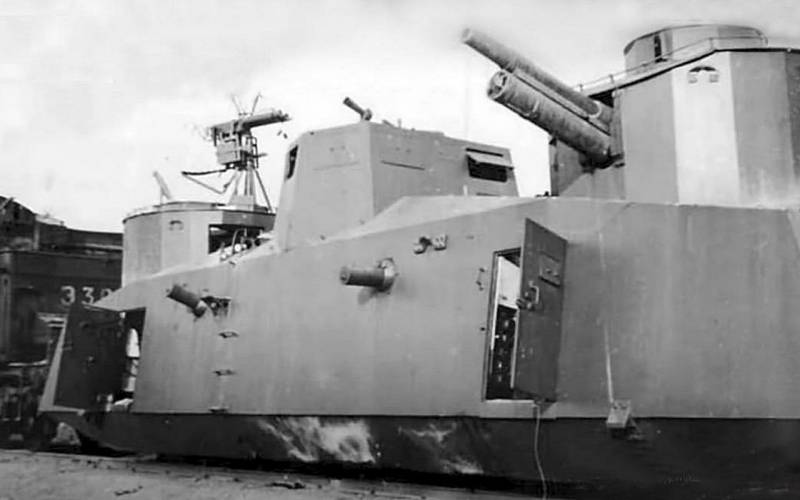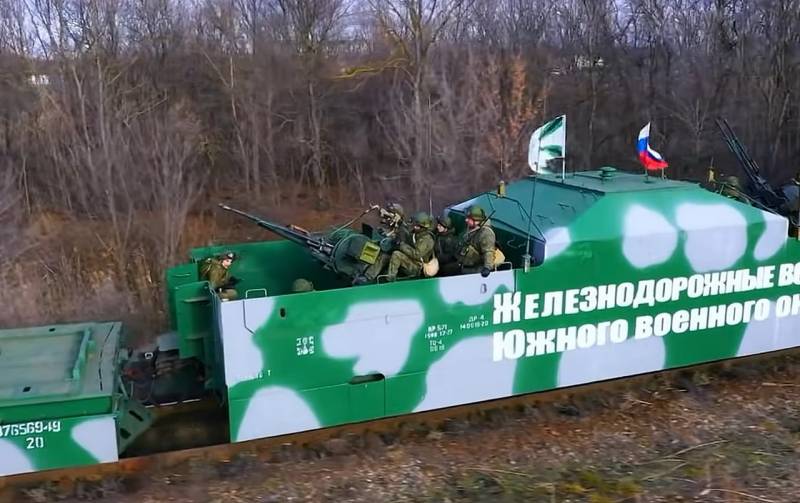Do the Russian army need armored trains?
The topic in the title will certainly seem unexpected to many. Yes, this article will talk about the most real armored trains. And with the prospects of their application, in fact, not everything is so simple.
We will not talk here about long-range weapons systems on a railroad track, such as the Dora cannon or the BZHRK “nuclear missile train”. The object of our attention will be precisely armored trains, created for direct contact with enemy forces.
A brief overview of the history of armored trains until the middle of the 20th century
An armored train is an armored self-propelled combat unit consisting of one or more railroad cars. Armored trains (abbreviated as "BP" or "bepo") were produced both serially and individually, both in the factory and handicraft.
The first armored trains appeared in the United States during the Civil War of the 1860s.
Armored trains were of the greatest importance in the wars of the late 19th - early 20th centuries. Their "finest hour" fell on the period of the First World War. Many armored trains fought in the civil war in Russia on both sides, as well as in the civil war in Spain.
In World War II, armored trains were also, of course, used by different countries. However, the new methods and means of warfare naturally gave them a much more modest place in the overall picture of hostilities. So, already at the very beginning of the Great Patriotic War, it became clear that the Bepo did not justify the hopes placed on them.
The limitations inherent in this type of weapon have almost completely manifested themselves:
- limited mobility (only forward and backward along the railway track);
- Poor armoring of cars and a locomotive (the thickness of the armor rarely exceeded 20 mm and was usually 10 - 15 mm);
- high profile of cars and locomotives, making them well visible and easily hit;
- the ability to easily restrict or impede mobility by damaging the railway track.
Armored trains quickly found themselves surrounded by the advancing enemy and fell prey to tanks and dive bombers.
Anti-aircraft armored trains played a significant role in the Great Patriotic War. Usually they were armed with anti-aircraft guns of medium and small caliber, as well as machine guns (large-caliber and conventional). They helped close numerous gaps in the air defense (AA) defense, helping to guard train stations, sidings and other facilities.
In addition to entire trains, separate air defense railway platforms were widely used. Usually it was a railway platform with one or two anti-aircraft guns. Sometimes she had sides made of armor plate or sleepers. These sites could be part of both armored trains and conventional trains, protecting them from aviation attacks.
Armored trains in the post-war period
The post-war development of jet weapons and anti-tank weapons, the appearance of nuclear weapons and a further increase in the maneuverability of the ground forces left almost no room for an armored train on the battlefield. That is why this type of military equipment rather quickly ceased to be regarded as a real fighting force.
An interesting episode of the revival of armored trains in the USSR occurred in the early 1970s, during a period of aggravation of relations with China. Then, to protect the eastern part of the Trans-Siberian railway, several armored trains were hastily built, each of which consisted of several identical sections - "armored cars".
"Letuchka" consisted of two identical 4-axle railway platforms and a small shunting locomotive located between them, sheathed with armor plates. Each of the platforms housed an ordinary tank and an "armored box" - a booth with loopholes for placing shooters and ammunition. The design of each platform allowed the tank to "dismount", and it could operate at some distance from the railroad bed.
Several of these trains were built.
In 1990, these trains were used in Azerbaijan, and a little later in Nagorno-Karabakh to guard railway stations, military echelons and civilian cargo.
In the mid-1990s, several so-called "special trains" operated in Chechnya as part of the railway troops of the Russian army, intended mainly for the restoration, maintenance and protection of the railway infrastructure.
All of them had in their composition a platform with two paired small-caliber automatic anti-aircraft guns ZU-23-2, closed with low armored sides, and a booth between them, made of sleepers and sheathed with armor plates. Otherwise, these trains were different and represented a collection of different cars, some of which were handicraftly protected using scrap materials.
Currently, the railway troops of the Southern Military District are armed with four special trains: Baikal, Amur, Terek and Don (according to other sources, only the first and second). At one time, Defense Minister Anatoly Serdyukov tried to remove them from service, but his order was canceled by his successor Sergei Shoigu.
During the war in Bosnia in the first half of the 1990s, the conflicting parties used makeshift armored trains. The most famous of them was the armored train "Kraina Express" of the Republic of Serbian Krajina. It was equipped with various types of artillery, small arms and even rocket weapons. In addition to armor, its cars were sheathed with reinforced rubber, under which rubble was filled.
Prospects for the use of armored trains
By analogy with historical examples, armored trains in the future may have a rather narrow niche of application, for example, in civil wars, where there is no widespread use of tanks, aircraft, cruise missiles, etc.
More or less massively they can be in demand, probably only if in the future, for some reason, a significant degradation (regression) of civilization (and, as a consequence, means of warfare) occurs.
As for the anti-aircraft weapons on the railway, then, apparently, it could be very useful in modern Russia, taking into account the extremely important importance of railway transport in it in the economy and defense, as well as a large length of railways, most of which are not covered by ground air defense.
In the event of a war with a well-armed enemy, it will suddenly become extremely important to protect transport infrastructure facilities and even individual trains. Therefore, the advance production and deployment of a sufficiently large number of railway platforms, for example, with the Pantsir air defense missile system, does not seem superfluous.
Given the modular design of this complex, it can be installed very quickly on conventional railway platforms. But, perhaps, it would be advisable to develop a special version, disguised as a covered freight car or freezer car, which will significantly increase its survivability.
Conclusion
Armored trains have a number of significant natural limitations compared to other types of weapons. In this regard, there is practically no place for them in a modern full-scale war. But in the future they may be in demand in military conflicts of low intensity, such as civil wars, which make these restrictions bearable.
Individual cars with air defense systems (especially short-range ones) can be very useful for a country like Russia.



Information